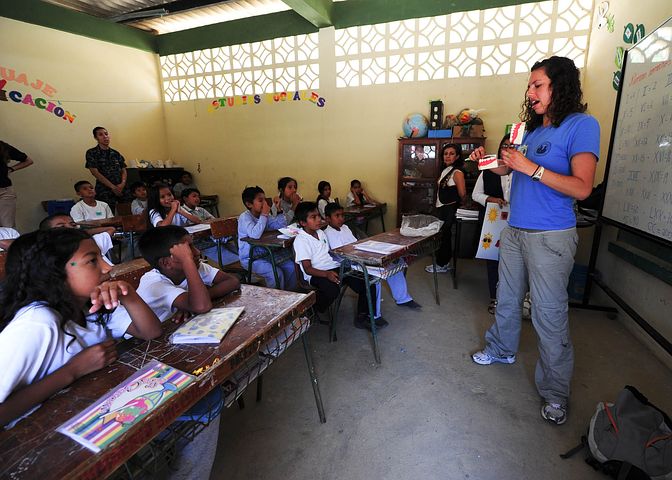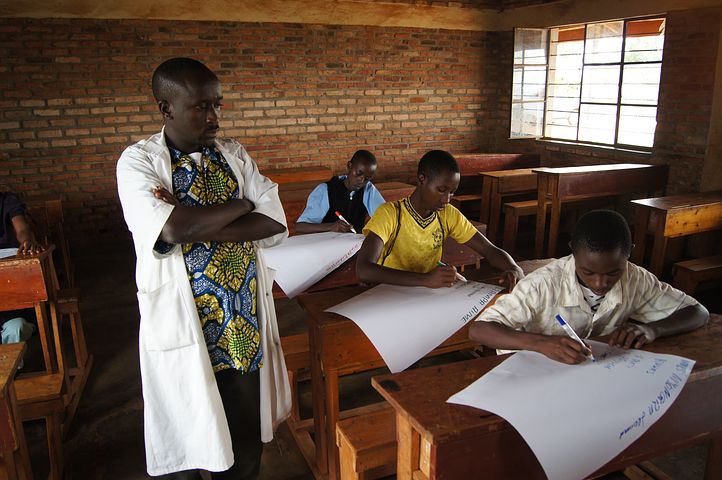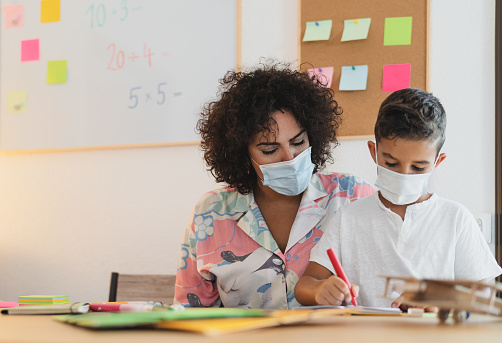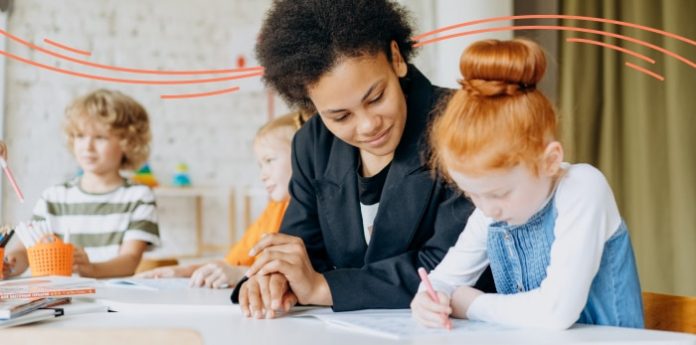Relationships are essential to survive in society. They provide emotional and social support to thrive. Especially in classrooms, relationships are crucial to creating a positive learning environment.
The teacher-student relationship is one of the vital human relationships that help build an engaging and important learning ecosystem. According to research, positive teacher-student relationships improve students’ engagement levels in the short and long run.
Math & ELA | PreK To Grade 5
Kids see fun.
You see real learning outcomes.
Watch your kids fall in love with math & reading through our scientifically designed curriculum.
Parents, try for free Teachers, use for free
Another study shows that positive teacher-student relationships can increase prediction and reduce nervousness among teachers. It helps teachers to personalize lessons based on individual students’ learning pace.
Overall, teacher-student relationship building is helpful for both teachers and students. So, let’s delve into this topic in-depth to elevate the education level.
Why are Teacher-Student Relationships Important?

Relationship building has shown underlying benefits to improving the classroom’s education level. However, several reasons back the need for positive teacher-student relationships, such as:
1. Strengthen Academic Structure
Improving academic performance is the ultimate goal of a teacher. Therefore, every educator aims to provide personalized training to their students. With a positive relationship, teachers can better understand the intellectual level of each student and customize lessons for them. In return, this creates an engaging classroom environment that pushes students to learn new things.
2. Safe and Comfortable Learning
Students will feel more comfortable in the classroom with casual relationships with their teachers. Students can openly share their opinions or discuss their problems with teachers when they feel safe around them.
3. Strengthen Parent-teacher Relationships
Positive teacher-student relationships can strengthen parent-teacher relationships. Teachers can better understand their students’ mental state when they have cordial relationships with them. In return, this will help teachers provide insightful reports to parents about their kids’ performance. Moreover, teachers can coordinate with parents to create more enjoyable and productive student learning strategies.
4. Boost Good Behavior Among Teens
The University of Cambridge has presented a study showing that positive teacher-student relationships boost good behavior in teenagers for up to 4 years. That means teachers should start building relationships with 10-11-year-old students to develop ‘prosocial’ behavior among them, such as altruism and cooperation. It will reduce behavior problems in the classroom, such as aggression, bullying, and rebellion.
5. Help Students with Physical Incapacity
Positive relationships can help teachers understand the limitations of physically incapable students. They can evaluate the mindset of disabled students and build an engaging classroom for them. Teachers can even customize the curriculum for less fortunate students after learning about their real challenges.
Key Elements of Positive Teacher-Student Relationships

Building a positive relationship with your students is not an overnight job. Every child is different and has unique social and emotional behaviors. Thus, it is difficult for teachers to connect with every student in a class and bond with them. However, it is not impossible if you focus on these relationship key elements:
1. Smooth Communication
Two-way communication is critical to nurturing a bond between students and teachers. Consistent communication allows teachers to interact with students and observe if they like new teaching strategies. In addition, students can express their concerns freely to teachers. Good communication is required to bridge the gap between students and teachers.
2. Genuine Concern
Genuine emotions build relationships. When a teacher spends a few minutes asking students how they are and what they learned today? Then, these small interactions will show students how much their teachers care about their well-being. Your genuine concern will warm students’ hearts for you, which is the first step to a long-lasting relationship.
3. Respectful Environment
If you want your students to express themselves freely, you must first harness a respectful ambiance in your classroom. When students know you will respect their thoughts, it will boost their confidence.
4. Equalism and Togetherness
Teacher-student relationships are nurtured more when students feel they are sailing in the same boat as teachers. Teachers can involve students in curriculum creation processes to stimulate a feeling of togetherness. When teachers value students’ opinions, it will automatically strengthen their bond.
5. Constructive Feedback
Educators should provide real-time constructive feedback to students. But, they should give criticism that improves students’ self-growth. Teachers should pick their vocabulary carefully while providing feedback to students. Your harsh words can demotivate students and create a rift in teacher-student relationships.
Related Reading: Best Teaching Strategies for This Year
How to Build Positive Teacher-Student Relationships to Improve Academic Excellence?

A positive teacher-student relationship is a two-way street. Students and teachers have to work together to build a positive relationship. However, teachers are the ones who have to initiate the process and provide a platform for students to bond. Here are a few teaching strategies that teachers can use to establish good relationships with their students:
1. Provide a Structure
Teachers have to lay down a good structure in the class for students to follow. They must use a specific tone while communicating with students to make them feel safe.
Rules and regulations are essential to define teacher-student relationships. For example, asking students before adopting a new teaching technique will set an example for students. They will also ask your permission before making decisions in class.
2. Be Passionate and Enthusiastic
Students do what they see and observe. If they find teachers excited about something, this will also spike their interest. Thus, being a teacher, you should show passion and enthusiasm to learn more about your students. It would help if you spent time interacting with your students in a simple setup, like during lunch break.
For example, discussing your hobbies, weaknesses, and strengths will motivate students to talk. So, teachers lead an example, and your students will follow you.
3. Make Learning Fun
Have you ever considered why PT and art teachers are most students’ favorite teachers? That’s because students have more fun during art and physical training classes. They will feel more engaged with the subjects, which will also help to strengthen the bond with subject teachers.
Therefore, you should aim to make learning fun for your class. It will strengthen your bond with students and make learning enjoyable in your classroom.
Today, teachers can explore different techniques to make learning fun. For example, using SplashLearn math games, teachers can make counting, patterns, and other math concepts fun for students.
4. Take an Extra Leap
A plain classroom and homework curriculum will not help you develop a positive relationship with your students. You must go the extra mile to make learning fun for your class.
For example, motivate your students to participate in extracurricular activities to learn new skills. You need to understand the likes and dislikes of your students to personalize learning for them.
Going the extra mile also means communicating with students no longer part of your class. Being a teacher, your main aim should be to help students — whether they are in your class or not.
5. Show Interest in Their Outside Classroom Life
Teachers must learn about their students’ lives outside the classrooms. This will help teachers see why a student behaves in a certain way in the class. They can better learn about their home conditions, passions, and preferences.
All this knowledge will help develop a personal bond with students to improve learning and education standards in your classroom.
Relationships Matters for Learning
If you want your students to excel academically, you must first develop a connection with them. You have to learn what helps motivate and engage them in your class.
Teacher-student relationships improve education standards and improve emotional learning levels among students. After knowing their students, teachers can select the proper teaching techniques and develop an effective curriculum. So, if you wish to leave a long-standing impact on your students’ minds, start building personal relationships with them today.
Related Reading: Best & Important Character Traits for Kids That All Parents Must Instill
Frequently Asked Questions
How can teachers maintain healthy boundaries with students?
It is often seen that students/teachers cross the boundaries of the teacher-student relationship, leading to a toxic environment in the classroom. Thus, teachers should clearly define relationship boundaries for students from the beginning. For example, you are their teacher, not a friend. So, they can’t address or follow you casually on social media platforms.
How can teacher-student relationships help teachers?
Positive teacher-student relationships are extremely beneficial for teachers. It helps teachers to get instant feedback from their students and improve their teaching strategies. When teachers are familiar with the class, they will feel less nervous and can confidently teach. It also helps teachers personalize lessons based on their students’ learning pace.
What is an inappropriate teacher-student relationship?
Inappropriate teacher-student relationships are those that cross certain boundaries. The boundaries can be crossed by teachers or students, ruining the essence of teacher-student relationships. Therefore, teachers and academic institutions should set proper classroom rules to develop teacher-student relationships.
























